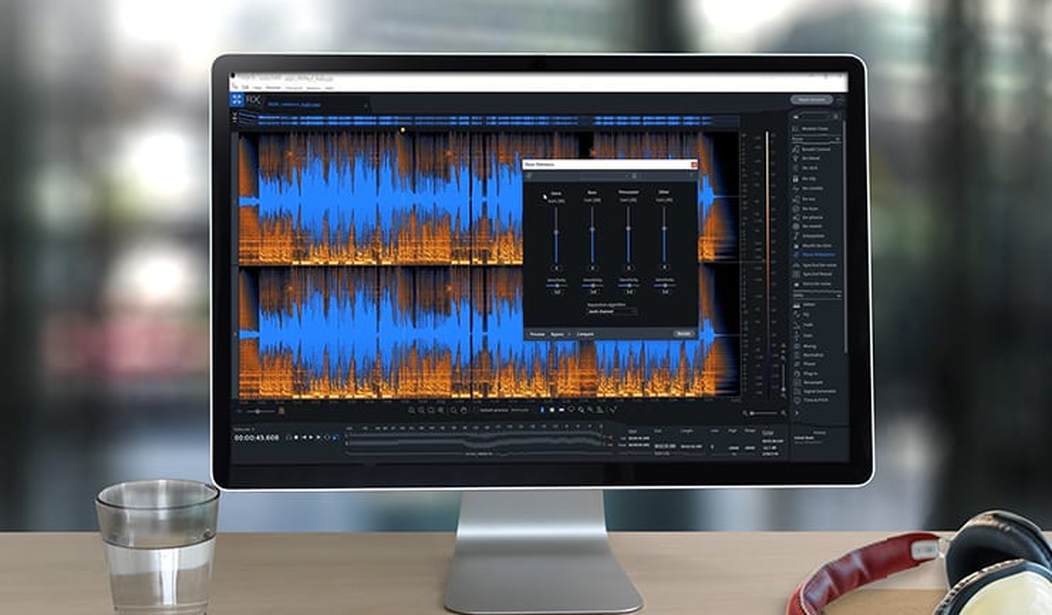Back in the fall of 2007, when Roger L. Simon asked me to produce PJM’s late lamented weekly series on Sirius-XM’s POTUS channel, I stumbled into a serious bit of good luck that made my life much easier: Boston-based Izotope, Inc. had just released the first iteration of their RX Audio Restoration and Post-production Processing Software. Right from the start, the RX line did a brilliant job of reducing hum, clicks, plosives (those popped-P sounds when someone is too close to the mic), and other noise from a recording. Being tasked with getting audio from a wide variety of sources, including podcasts, video recordings and telephone interviews and cleaning it up for radio presentation, RX was my secret weapon. I found it also worked terrifically on music recording, reducing or eliminating such distracting elements as finger squeaks when changing chords on a guitar, amplifier hum, and digital clicks.
Unlike most earlier noise reduction programs, RX made it possible to zoom into a individual distracting click or pop and drill down into tight granular-level details, much like Photoshop makes it possible to manipulate individual pixels in a Photo. This means it’s often possible to remove those tiny imperfections, without removing the actual musical or vocal content.
Later versions of RX became increasingly aimed at the world of video post production, with such features as Dialogue Isolate and Ambience Match. (Regarding the latter, Izotope’s help files note that it “lets you match the noise floor of one recording to another recording. For example, you can recreate the ambience of a live set on your ADR tracks.”) Beginning with RX5, Izotope split its RX program into standard and advanced versions, with the latter aimed towards film and video post-production houses who do extensive dialogue editing. (There is now a stripped-down RX Elements version as well. This chart lists the differences between the three programs.)
In Through the Music Rebalance Door
Izotope recently released the latest iteration of RX, RX7. While all of the previous modules are still there, in a return to Izotope’s origins as a music-oriented company, one of RX7’s most intriguing new features is called Music Rebalance. Professional audio mixers routinely create audio “stems” to group related elements of a multitrack recording mix. This way, a 24 to 48 track or more (sometimes waaay more) recording can quickly be boiled down to its core elements and reassembled, in case something needs to be remixed to create, say, a karaoke version of the song that will have all of the instruments mimed on TV, with only a live lead vocal. Or a different mix for a soundtrack or 12-inch version of a recording. Or if the record label decides it wants the lead vocal louder — or even if a band’s singer quits the group at the 13th hour.
Stem tracks typically consist of:
- Lead vocal
- Background vocals
- Solo instruments, if there is say, a prominent guitar or sax solo present
- The main backing instruments
- The bass guitar
- The drums
However, sometimes the original tracks of a recording get lost over time. In the past, remixing a track without the original multitrack recording was impossible. However, RX7’s new Music Rebalance feature will separate a stereo track into voice, bass, percussion, and for everything else, “other.”
I experimented with Music Rebalance to remix wave files of some of my old four-track cassette recordings from my college-era band days. Separating their core elements into individual tracks means they can be imported into a modern DAW, and then rebalanced, with reverb and compression plugins from the 21st century added to enhance the sound. I also experimented with creating a mash-up of Led Zeppelin’s classic “All My Love” from their 1979 album In Through the Outdoor, taking the original track and fading in at the end the bootleg work mix version with an extended coda and final guitar solo missing from the album version.
My four track recordings and the Led Zep bootleg were both pretty low-fi to begin with, and depending upon your source material, there could well be artifacts present if a newly minted lead vocal stem is soloed, but once all the elements are combined, they should be much less apparent. As with most of the features in RX, Music Rebalance will likely only get better in future elements. But as it stands now, this is already a very useful tool, for remixing and creative applications:
Repair Assistant Speeds Up Workflow
In earlier versions of RX, once a problematic vocal or music track was imported into the program, it often took a bit of experimentation to find which of its applets would do the best job of eliminating or reducing a recording’s flaws. In order to speed up the discovery process, RX7 provides what they’ve dubbed the Repair Assistant. Depending upon how exposed this track is in a final mixdown (say if it’s the lead vocal or a prominent guitar solo), you still may want to do some additional tweaking to reach perfection, but for many applications, the choice presented by the new Repair Assistant in the top right of the program may be all you need. Clicking on it, the assistant asks if the file loaded is “Dialogue, Music, Other (e.g. sources with both dialogue and music).” One the choice is made, the Repair Assistant searches the audio file for clipping, clicks, hum, and noise. RX7’s help file notes that “If issues are not detected in any of the four categories, Repair Assistant will generate 3 basic clean-up processing chains for the selected source type using data learned during the analysis pass.”
While Izotope is an extremely useful tool, it shouldn’t be viewed as a crutch. For example, while it can remove reverb and plosives, this shouldn’t be viewed as an excuse to forgo recording a lead vocal in room equipped with proper acoustic treatments, even if it’s a few duvets and a Reflexion filter or GIK’s Portable Isolation Booth panels. The better the recording quality at the source, the less cleanup work will be required later, which means that fewer digital artifacts will be present, which is particularly important on something as exposed as a led vocal.
But when it’s cleanup time, whether you produce video for TV or YouTube, interviews for radio or podcasts, or produce music, RX7 is a tremendously useful tool, both for adding professional sheen to a recorded track, and now for remixing material where the original multitrack recordings cannot be found.










Join the conversation as a VIP Member